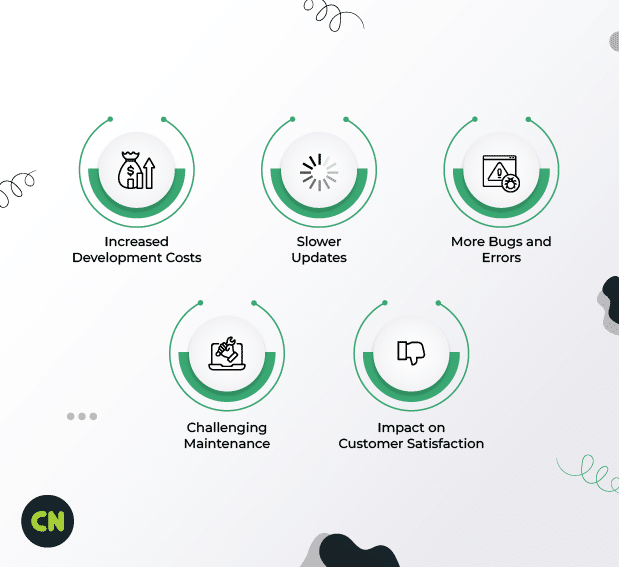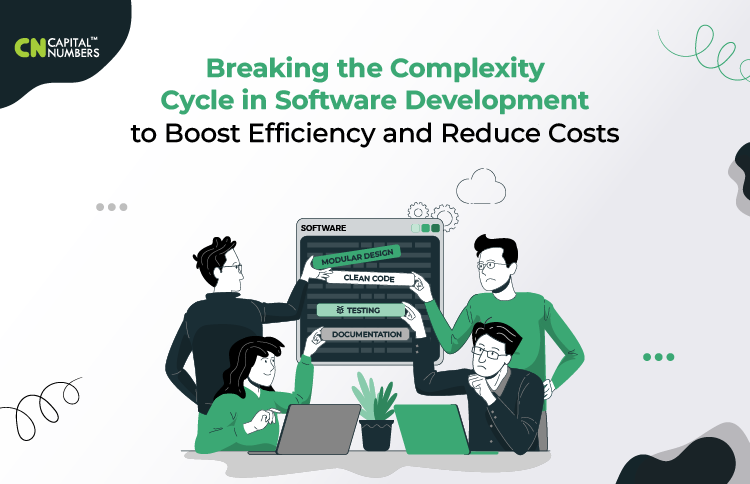Breaking the Complexity Cycle in Software Development to Boost Efficiency and Reduce Costs
Table of Contents
In the fast-paced world of software development, complexity is often seen as an inevitable byproduct of innovation. However, when not managed properly, this complexity can cause inefficiencies, higher costs, and diminished product quality. The challenge facing today’s software developers is not just about building advanced features or implementing cutting-edge technologies; it’s also about breaking the complexity cycle that often hampers progress and inflates budgets.
Here, we will delve deep into the world of complexity in software development. We aim to understand its roots, how it impacts the development process, and, crucially, how it can be effectively managed and reduced. Our focus is clear: to boost efficiency and reduce costs for software development companies. We will explore actionable strategies and best practices to simplify complex processes, streamline development workflows, and ensure that projects remain on track and within budget.
Understanding Software Complexity
Complexity in software development impacts the success and manageability of software projects. This complexity comes in three types: essential, accidental, and incidental.
- Essential complexity: It is the inherent difficulty in solving a specific problem in software development. Essential complexity cannot be simplified or eliminated because it is essential to the problem.
- Accidental complexity: It arises from the development process itself, often due to choices in technology or design that aren’t fundamental to the software’s purpose.
- Incidental complexity: It emerges over time, often due to evolving requirements or feature creep, leading to a tangled and hard-to-manage codebase.
All these types of complexity make the software harder to develop, modify, and maintain, thereby increasing initial development and ongoing maintenance costs. Effectively managing these complexities ensures that software projects remain efficient, user-friendly, and cost-effective.
Early Warning Signs of Complexity in Software
When software development gets too complex, there are some clear signs to look out for:
- Hard to Change Code: It becomes tough for developers to understand and change the code. They might be scared to make changes because they don’t want to break anything.
- More Bugs: The software has more mistakes and problems than usual. This happens because complex software can have issues that are hard to spot and fix.
- Slower Work: Developers take longer to do their work. Simple tasks take a lot of time because the software is too complicated.
- Trouble Adding New Things: Adding new features or parts to the software is hard. This usually leads to delays and sometimes even more problems.
These signs show that the software is getting too complex, and it’s time to find ways to simplify things for everyone working on it.
Business Impact of Complexity in Software Development

Complexity in software development can greatly impact a business, leading to challenges and higher costs. It also means the development company requires more time and specialized skills to develop, which increases expenses. Also, such software tends to be slower to update with new features, affecting competitiveness in the market. To be on the safe side, some companies opt for MVP (Minimum Viable Product) development, initially launching with essential features and then expanding to a full-fledged product upon success. While this strategy can be effective in certain scenarios, it’s not a one-size-fits-all solution for all projects.
The business impact of the complexity in software development includes:
- Increased Development Costs: More resources are needed due to complexity.
- Slower Updates: Takes longer to add new features or improvements.
- More Bugs and Errors: Higher chance of problems in the software.
- Challenging Maintenance: Difficult and costly to maintain and update.
- Impact on Customer Satisfaction: Potential for system issues affecting users.
The drawbacks of complex software underscore the importance of keeping software systems simple and manageable.
Simplification as a Key Strategy
In software development, simplification is a key strategy that embraces the ‘Less is More’ philosophy. This approach focuses on the software’s core functionality, avoiding unnecessary features that complicate the system. By keeping things simple, the software becomes easier to use and maintain:
- Keep It Simple: Focus only on the essential features.
- Avoid Adding Too Much: Don’t add unnecessary extras.
- Think of the User: Make the software easy and clear for people to use.
- Easier to Handle: Simple software is easier to update and fix.
Thus, software becomes more efficient and less costly to manage over time.
Effective Project Management to Counter Complexity
Effective project management is key to countering complexity in software development, especially in custom software development. Project managers are critical in overseeing the development process, ensuring that complexity is managed effectively from start to finish. Implementing strategic methodologies and clear planning can significantly influence the project’s success and manageability.
- Agile Methodology: Agile methodology simplifies software development by breaking the project into small, manageable parts (sprints) and allowing for regular changes and updates. This approach helps teams work better together and meet the needs of users more effectively.
- Setting Realistic Timelines and Milestones: Proper planning and setting achievable goals make software development smoother and less complex. It helps in planning work better, avoids overloading the team, and makes it easier to track and adjust progress as needed.
Technical Strategies to Reduce Software Complexity
Applying effective technical strategies helps developers reduce complexity in the development process, making the software more manageable, scalable, and adaptable to changes. Here are a few strategies to follow:
- Clean Code Practices: Write clear, simple, and easy-to-understand code. This includes using descriptive naming conventions and breaking down complex functions into smaller, more manageable pieces.
- Modular Design: Break down program functions into smaller, manageable modules. Each module addresses a specific function or feature, simplifying understanding and maintenance.
- Regular Refactoring: Review and improve the codebase to remove redundancies and simplify complex structures. It helps in keeping the code efficient and manageable.
- Automated Testing and Continuous Integration: Implement robust automated testing and continuous integration processes. These practices help identify and resolve complexities early in the development cycle.
- Effective Documentation and Code Comments: Maintain clear documentation and use meaningful comments, especially for intricate code segments. Proper documentation is crucial for understanding the system’s overall architecture and individual components.
Tools and Technologies to Ensure Simplification
Ensuring simplification in software development can be effectively achieved using various tools and technologies.
- Integrated Development Environments (IDEs): Modern IDEs offer features like code completion, syntax highlighting, and refactoring tools. These features help developers write cleaner, more efficient code and simplify complex code structures.
- Version Control Systems: Tools like Git help manage code changes and track the evolution of the software, making it easier to identify and reduce complexity over time.
- Static Code Analysis Tools: These tools analyze code for potential errors, adherence to coding standards, and other complexity metrics. They are invaluable in maintaining code quality and simplicity.
- Automated Testing Tools: Tools for unit testing, integration testing, and continuous integration enable developers to catch and fix errors early, preventing complexity within the system.
- Documentation Generators: Technologies like Javadoc or Doxygen automatically generate documentation from the source code. This helps maintain up-to-date and comprehensive documentation, which is essential for understanding complex systems.
- UML and Modeling Tools: Tools for creating Unified Modeling Language (UML) diagrams can help visualize the system’s architecture, making it easier to understand and simplify.
- Profiling and Performance Analysis Tools: These tools help identify performance blockage and complex code regions, guiding developers on where simplification is needed.
- Containerization and Orchestration Tools: Tools like Docker and Kubernetes help manage and deploy applications in a modular, controlled manner, reducing the complexity of deployment and scaling.
These software development tools and technologies can help achieve and maintain simplicity during software development. They provide the necessary support to streamline development processes, enhance code quality, and ensure the final product is robust and manageable.
Implementing DevOps and Agile to Reduce Complexity and Cost
Implementing DevOps and Agile approaches reduces complexity and cost in software development. They ensure a more efficient, collaborative, and responsive development environment.
- Continuous Integration/Continuous Deployment: Streamlines development and deployment processes, ensuring faster and more reliable delivery.
- Collaborative Culture: Encourages teamwork between developers and operations, leading to better problem-solving and innovation.
- Iterative Development: Allows for regular feedback and quick adaptation to changes, reducing errors and rework.
- Resource Optimization: Efficiently uses resources, reducing waste and lowering operational costs.
- Rapid Problem Resolution: Quick identification and resolution of issues, improving system stability and user satisfaction.
Read More: How to Manage Your Offshore Software Development Team Efficiently
Final Thoughts
Reducing complexity in software development is critical for achieving the software’s success and cost-efficiency. Simplifying the development process is key, and adopting methodologies like Agile and DevOps is instrumental in this regard. These methodologies not only streamline workflows but also foster collaboration and continuous improvement, cutting down complexity and costs. The use of modern tools and technologies, such as automated testing and continuous integration/deployment, further eases complex tasks, leading to more efficient development cycles.
Looking ahead, the integration of AI in software development will bring changes. AI’s ability to automate routine tasks, analyze data, and predict outcomes promises to streamline the development process further. It allows developers to focus on more strategic aspects, thereby enhancing software quality and efficiency. As technological advancements continue, a more streamlined, cost-effective, and simplified approach to software development is expected, resulting in robust and user-friendly software solutions. The future of software development lies in adaptability and a continuous focus on simplifying processes in response to the evolving technological landscape and user needs.














